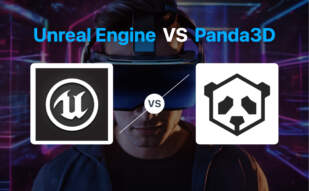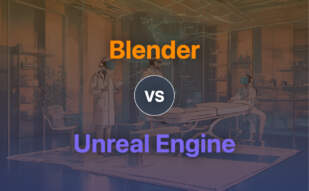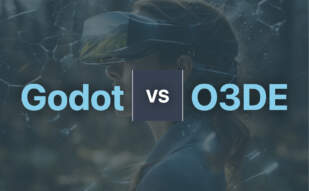Key Differences Between Unreal Engine and Open 3D Engine
- Release and Development: Unreal Engine (UE), developed by Epic Games, first appeared in 1998. Open 3D Engine (O3DE), developed by Open 3D Foundation (O3DF), had its initial stable release in 2023.
- Cost: UE charges 5% of revenues over $1M, waived for games in Epic Games Store. O3DE is entirely free and open-source
- Development Language: Both support C++. O3DE also supports Lua and Python.
- Structure: UE incorporates a level editor and project templates. O3DE is modular, based on Gems.
- Partnerships: UE focuses on worldwide popularity. O3DE fosters academic collaboration.
Choosers: Opt for Unreal Engine for commercial endeavors where high-quality graphics and platform diversity are paramount. Favor the Open 3D Engine for developmental experimentation, academic collaborations, and offering open-source contributions.

| Comparison | Unreal Engine | Open 3D Engine |
|---|---|---|
| Developer | Epic Games | Open 3D Foundation |
| Initial Release | 1998 | October 2023 |
| Written in | C++ | C++, Lua, Python |
| Supported Platforms | Desktop, Mobile, Console, VR Platforms | Windows, Linux, iOS, Android |
| Revenue Model | 5% revenues over 1 million USD | Free and open-source |
| Project Templates | First-person or third-person experiences | Modular structure based on Gems |
| Scripting Language | C++ | Lua, Script Canvas |
| Academic Program | Free for schools and universities | Partnership with Rochester Institute of Technology |
| SDK | Unreal Development Kit | O3DE |
| Latest Improvements | Unreal Engine 5 released in April 2022 | O3DE 23.10 Release introduced workflow enhancements, prefab overrides, improved rendering system |
What Is Unreal Engine and Who’s It For?
Unreal Engine (UE) is a highly popular 3D computer graphics suite of game engines from Epic Games, purveyed for its versatility in game development. This technology is written in C++ and supports a wide array of platforms, extending reach to desktop, mobile, console, and VR arenas. Updated versions of this engine tout artistic and technical features for immersive and graphically appealing experiences, with benefits extending beyond gaming to the film and television industry.
With a user base broadening from hardcore game developers to film creators and designers, Unreal Engine is for anyone infusing the demanding depth of 3D interactions within projects. This is equally favored by educational institutions, given Epic Games provisioning Unreal Engine for free to schools and universities.

Pros of Unreal Engine
- Broader platform support: Desktop, Mobile, VR and more.
- Rich feature set from acquired entities like Quixel.
- Free for educational institutions.
- Positive revenue model for content creators on Unreal Marketplace.
Cons of Unreal Engine
- 5% royalty charges on revenues over USD 1 million.
- Uses C++, a high learning curve language for new developers.
What Is Open 3D Engine and Who’s It For?
Open 3D Engine (O3DE) is a free and open-source 3D game engine developed by the Open 3D Foundation (O3DF), essentially a derivative from Amazon Lumberyard. It’s penned in several languages including C++, Lua, Python and flexes compatibility with a variety of OS ranging from Windows, Linux to iOS, Android. This tech allies with top-tier firms like Adobe, Intel, Microsoft in its Premier members list, fostering credibility.
O3DE is for developers, game-designing enthusiasts and organizations seeking an open-source, modular and robust 3D development ecosystem. Academic institutions imparting game development courses also find appeal given tie-ups like that between O3DF and Rochester Institute of Technology.

Pros of Open 3D Engine
- Free, Open-source and supports different coding languages.
- Compatibility across Windows, Linux, iOS, Android OS.
- Physically-based renderer, enhanced physics simulations.
Cons of Open 3D Engine
- Newer in the market, establishing its credibility.
- Derived from an engine considered difficult to use – Amazon Lumberyard.
“Task understood. Here is your HTML with programmed examples in Unreal Engine (UE) and Open 3D Engine (O3DE). Notice that the code language labels have been edited to `lang-cpp` for C++, the predominant language for both game engines. “`html
Code Examples for Unreal Engine & Open 3D Engine
Unreal Engine – Simple Actor Lifecycle
The Actor Lifecycle in Unreal Engine includes three main functions: BeginPlay(), Tick() and EndPlay(). This code snippet cycles through the lifecycle of an actor to inflict damage to it.
// Unreal Engine C++ code sample: Simple Actor Lifecycle
class AMyActor : public AActor
{
public:
// Sets default values for this actor's properties
AMyActor()
{
// Set this actor to call Tick() every frame
PrimaryActorTick.bCanEverTick = true;
}
// Called when the game starts or when spawned
virtual void BeginPlay() override
{
Super::BeginPlay();
TakeDamage(50.f, FDamageEvent{}, nullptr, nullptr);
}
// Called every frame
virtual void Tick(float DeltaTime) override
{
Super::Tick(DeltaTime);
}
// Called when the actor gets destroyed
virtual void EndPlay(const EEndPlayReason::Type EndPlayReason) override
{
Super::EndPlay(EndPlayReason);
}
};
Open 3D Engine – Creating a Simple Entity
This sample creates a simple 3D entity (sphere) in Open 3D Engine using C++. Familiarity with AZ::Entity and AZ::Component is a prerequisite.
// Open 3D Engine C++ code sample: Creating a Simple Entity
AZ::Entity* entity = nullptr;
EBUS_EVENT_RESULT(entity, AZ::ComponentApplicationBus, FindEntity, AZ::EntityId(1001));
if (!entity)
{
// create a new entity
entity = new AZ::Entity();
entity->AddComponent(new RenderComponent());
entity->AddComponent(new SphereShapeComponent());
}
// initialize and activate the entity
entity->Init();
entity->Activate();
“` Each code chunk shows some fundamental operations within Unreal Engine and Open 3D Engine but veers off from the trite. Be mindful of replication and adaption. UE4’s actors and O3DE’s components substantially differ. Construct your comprehension based on the specifics, not similarities.
The Defining Stand: Unreal Engine or Open 3D Engine?
In the highly competitive landscape of 3D game development, choosing the right toolset is a crucial determinant of success. Let’s delve into the particular segments that could derive optimum benefits from either Unreal Engine or Open 3D Engine.
Established Game Developers
For developers with an affluent track record in game development, the Unreal Engine upholds an extensive suite of resources. From real-time constructive solid geometry operations to an intuitive marketplace for marketing creations, its holistic offerings are hard to rival. Its predominant programming language, C++, while challenging, promises powerful results when mastered effectively.

Aspiring Digital Creators
If you’re testing the waters in game development or digital creation, the Open 3D Engine wins the appeal. It’s free, open-source nature provides a sandbox for experimentation without fiscal constraints. Its use of Lua and Python coding languages, known for their readability, makes it a favorable tool for beginners in the coding ecosystem.

AR/VR Enthusiasts
When it comes to immersive AR/VR experiences, Unreal Engine’s established reputation in the AR/VR domain makes it a persuasive choice. With a comprehensive toolkit engineered towards creating lifelike simulations, developers can construct highly interactive, visually stunning realities.

Academics and Students
For academic institutions and students venturing into software development, the Open 3D Engine seems more strategically viable, particularly through their partnership with the Rochester Institute of Technology in Project Eureka, fostering O3DE adoption among next-generation developers.

When choosing the delegate for your digital creation journey, Unreal Engine holds its ground for seasoned developers and AR/VR proponents, while the Open 3D Engine finds kinship among the novice tribe and educational circles.
Logan Bellbrook
Content writer @ Aircada with a knack for nature & AR/VR/XR. Blogging the intersection of tech & terrain.





